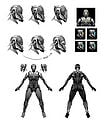Powered exoskeleton: Difference between revisions
From Halopedia, the Halo wiki
BaconShelf (talk | contribs) m (Reverted edits by 122.163.99.173 (talk) to last revision by Editorguy) Tag: Rollback |
BaconShelf (talk | contribs) m (Protected "Powered exoskeleton": Excessive spamming ([Edit=Allow only autoconfirmed users] (indefinite))) |
(No difference)
| |
Revision as of 13:45, November 21, 2021
| There is more information available on this subject at Powered exoskeleton on the English Wikipedia. |
A powered exoskeleton is a mobile machine consisting primarily of a skeleton-like framework worn by a person and a power supply that supplies at least part of the activation energy for limb movement.
Description
Powered exoskeletons are designed to physically assist and, in many cases, protect the wearer. They may be designed to assist and protect soldiers and construction workers, or to allow people to survive in other dangerous environments. A wide medical market exists for powered exoskeletons to provide mobility assistance for aged and infirm people. Other possibilities include rescue work, such as in collapsed buildings, in which the device might allow a rescue worker to lift heavy debris, while simultaneously protecting him from falling rubble.
The MJOLNIR Powered Assault Armor designed by Dr. Catherine Halsey is the most sophisticated UNSC powered armor project so far. As one of its main strengths, the MJOLNIR system eschews traditional mechanized joints in favor of a strength-enhancing layer of electroactive liquid crystal and provides a cybernetic link which boosts the wearer's reactions by a factor of five.[1] While it is the most successful UNSC powered armor project, MJOLNIR is by no means the only effort to physically augment soldiers in combat. The HRUNTING Mark III [B] Cyclops and the HRUNTING/YGGDRASIL Mark I were exoskeleton systems derived from earlier prototypes developed by exoskeleton programs which predated MJOLNIR.[2] Large-scale powered exoskeletons became more common in the years following the Human-Covenant War, with at least one model, the Mantis, seeing battlefield use.
The Semi-Powered Infiltration armor predominantly used by the Spartan-III supersoldiers provides modest physical enhancement[3] as well as a rudimentary active camouflage by means of photoreactive panels, allowing covert operations in enemy territory.[4] RKD, an Earth think-tank, created Project HAYABUSA concurrently with MJOLNIR and while the two were developed separately, they share many characteristics, and are interchangeable to a degree.[5]
In 2558, Michael Crespo wore an older suit of ODST armor from the early Human-Covenant war, which apparently had an exoskeleton installed in it. It was noted to be significantly less capable than MJOLNIR Powered Assault Armor.[6]
The Forerunners' personal armor offered powered support to some extent. For combat use, they also developed armor suits known as combat skins, using a class system based on numbers, on which the MJOLNIR Mark V[7] and Mark VI[8] would be rated Class 2.
Known powered exoskeletons
There are form fitting exoskeleton suits that act as armor, and there are larger exoskeletons that act as vehicles.
Armored suits
Forerunner
- Personal armor - Body-assist armor worn by virtually all Forerunners in everyday life
- Combat skin - Armor worn by Forerunners in battle
Human
- Hayabusa Powered Assault Armor - A UNSC powered armor system similar to the MJOLNIR armor
- MJOLNIR Powered Assault Armor - The performance-enhancing body armor first used by the SPARTAN-IIs and later by all Spartans
- Mark I, Mark II, and Mark III - Prototype iterations of MJOLNIR, created before the first production model.
- Mark IV - First iteration of MJOLNIR to entire mass production and see combat service
- Mark V - Introduced energy shields and artificial intelligence housing
- Mark VI - Introduced automated biofoam injectors
- Mark VII - Last of GEN1. Only known use is by Naomi-010
- GEN2 - A broad array of suits developed after the Human-Covenant War
- GEN3
- Semi-Powered Infiltration armor - The armor used by most SPARTAN-IIIs
- Nightfall armor - A suit of powered armor used by ONI operatives on missions in hazardous environments
Ancient human
- Ancient human battle armor suit -This powered armor was used by Ancient humans during Human-Forerunner wars. This armor works very similar to Combat Skin.[9]
San'Shyuum
- Fighting skin - Highly advanced powered armor worn by Prelate in battle.
Jiralhanae
- Atriox's armor - Atriox dons an augmented power gauntlet which artificially enhances his strength to a significant degree.[citation needed]
Vehicles/Mechs
Forerunner
Human
- Cargo walker
- HRUNTING and YGGDRASIL
- HRUNTING Mark III (B) Exoskeleton - Also known as the Cyclops; a large exoskeleton mainly designed for non-combat tasks, such as construction and dock work
- HRUNTING/YGGDRASIL Mark I Armor Defense System - An advanced development of a pre-MJOLNIR exoskeleton system
- HRUNTING/YGGDRASIL Mark II [D] Armor Defense System - Also known as the Mega-Mantis, a very large armored fighting vehicle akin to the later Mark IX "Mantis"
- HRUNTING/YGGDRASIL Mark II [J] Armor Defense System - Also known as the Colossus, a successor to an older exoskeleton in the same line, the HRUNTING/YGGDRASIL Mark II [D]
- HRUNTING/YGGDRASIL Mark IX Armor Defense System - A powered exoskeleton/armored fighting vehicle used by the UNSC Marine Corps after the Human-Covenant War
- Mark I prototype exoskeleton - A powered exoskeleton prototype, which was worn by trainers during combat training with Spartan-II trainees.
- Mark III exoskeleton - A powered exoskeleton which would later be adopted by Project: HRUNTING, producing the Cyclops.
- Munitions loader
- Skyfire Exosuit
- Unidentified powered exoskeleton - A powered exoskeleton prototype, predating MJOLNIR.
Unggoy
- Goblin - A bipedal battlesuit of Unggoy design
Jiralhanae
- Decimus' exoskeleton - a custom combat suit worn by Atriox's right hand
- Breacher Exosuit
Gallery
An exoskeleton piloted by Decimus.
Sources
- ^ Dr. Halsey's personal journal
- ^ Halo: The Essential Visual Guide, page 44
- ^ Halo Mythos, pages 76-77
- ^ Halo: Ghosts of Onyx, page 16
- ^ Halo 3
- ^ Halo: Bad Blood, Chapter 17
- ^ Halo: Combat Evolved, campaign level The Library
- ^ Halo 3, campaign level Halo
- ^ Halo: Cryptum, page 112




![A HRUNTING/YGGDRASIL Mark II [D] armor system under construction.](https://halo.wiki.gallery/images/thumb/8/8d/Cyclops_mark_II.jpg/200px-Cyclops_mark_II.jpg)






